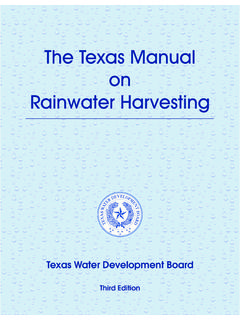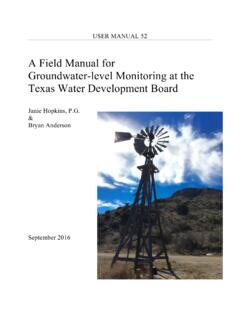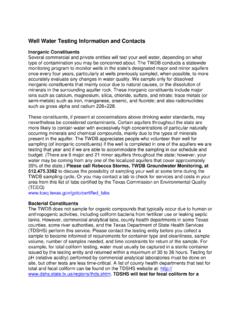Transcription of The Texas Manual on Rainwater Harvesting
1 The Texas Manual on Rainwater Harvesting Texas water Development Board Third Edition The Texas Manual on Rainwater Harvesting Texas water Development Board in cooperation with Chris Brown Consulting Jan Gerston Consulting Stephen Colley/Architecture Dr. Hari J. Krishna, , Contract Manager Third Edition 2005. Austin, Texas Acknowledgments The authors would like to thank the following persons for their assistance with the production of this guide: Dr. Hari Krishna, Contract Manager, Texas water Development Board, and President, American Rainwater Catchment Systems Association (ARCSA);. Jen and Paul Radlet, Save the Rain; Richard Heinichen, Tank Town; John Kight, Kendall County Commissioner and Save the Rain board member; Katherine Crawford, Golden Eagle Landscapes; Carolyn Hall, Timbertanks; Dr. Howard Blatt, Feather & Fur Animal Hospital; Dan Wilcox, Advanced Micro Devices; Ron Kreykes, ARCSA board member.
2 Dan Pomerening and Mary Dunford, Bexar County; Billy Kniffen, Menard County Cooperative Extension; Javier Hernandez, Edwards Aquifer Authority; Lara Stuart, CBC;. Wendi Kimura, CBC. We also acknowledge the authors of the previous edition of this publication, The Texas Guide to Rainwater Harvesting , Gail Vittori and Wendy Price Todd, AIA. Disclaimer The use of brand names in this publication does not indicate an endorsement by the Texas water Development Board, or the State of Texas , or any other entity. Views expressed in this report are of the authors and do not necessarily reflect the views of the Texas water Development Board, or any other entity. Table of Contents Chapter 1 1. Chapter 2 Rainwater Harvesting System 5. Basic Components .. 5. The Catchment 5. Gutters and Downspouts .. 6. Leaf 7. First-Flush Diverters.
3 8. Roof 10. Storage 10. Pressure Tanks and 16. Treatment and Disinfection Equipment .. 17. Chapter 3 water Quality and 21. Considerations for the Rainwater Harvesting System Owner .. 21. water Quality Standards .. 22. Factors Affecting water 22. water Treatment .. 23. Chapter 4 water Balance and System 29. How Much water Can Be Captured? .. 29. Rainfall Distribution .. 30. Calculating Storage 32. The water Balance Method Using Monthly Demand and Supply .. 32. Estimating 33. Estimating indoor water demand .. 33. Indoor water 35. Estimating outdoor water demand .. 36. Chapter 5 Rainwater Harvesting Guidelines .. 41. RWH Best Management 41. water Conservation Implementation Task Force 41. American Rainwater Catchment Systems 41. Building 41. Cistern Design, Construction, and Capacity .. 42. Backflow Prevention and Dual-Use Systems.
4 42. Required Rainwater Harvesting 43. Chapter 6 Cost 45. Comparing to Other Sources of 51. i Chapter 7 Financial and Other Incentives .. 53. Tax Exemptions .. 53. municipal 54. Rainwater Harvesting at State Facilities .. 55. Performance Contracting .. 56. Appendix A References .. A1. Appendix B Rainfall Data .. A7. Appendix C Case Studies .. A11. Appendix D Tax Exemption Application Form .. A25. ii Chapter 1. Introduction Rainwater Harvesting is an ancient extending their use; Rainwater technique enjoying a revival in eliminates the need for a water popularity due to the inherent quality of softener and the salts added during Rainwater and interest in reducing the softening process. consumption of treated water . Rainwater is sodium-free, important Rainwater is valued for its purity and for persons on low-sodium diets.
5 Softness. It has a nearly neutral pH, and Rainwater is superior for landscape is free from disinfection by-products, irrigation. salts, minerals, and other natural and man-made contaminants. Plants thrive Rainwater Harvesting reduces flow to under irrigation with stored Rainwater . stormwater drains and also reduces Appliances last longer when free from non-point source pollution. the corrosive or scale effects of hard Rainwater Harvesting helps utilities water . Users with potable systems prefer reduce the summer demand peak and the superior taste and cleansing delay expansion of existing water properties of Rainwater . treatment plants. Archeological evidence attests to the Rainwater Harvesting reduces capture of Rainwater as far back as 4,000 consumers' utility bills. years ago, and the concept of Rainwater Perhaps one of the most interesting Harvesting in China may date back 6,000.
6 Aspects of Rainwater Harvesting is years. Ruins of cisterns built as early as learning about the methods of capture, 2000 for storing runoff from storage, and use of this natural resource hillsides for agricultural and domestic at the place it occurs. This natural purposes are still standing in Israel synergy excludes at least a portion of (Gould and Nissen-Petersen, 1999). water use from the water distribution Advantages and benefits of Rainwater infrastructure: the centralized treatment Harvesting are numerous (Krishna, facility, storage structures, pumps, 2003). mains, and laterals. The water is free; the only cost is for Rainwater Harvesting also includes land- collection and use. based systems with man-made landscape The end use of harvested water is features to channel and concentrate located close to the source, Rainwater in either storage basins or eliminating the need for complex and planted areas.
7 Costly distribution systems. When assessing the health risks of Rainwater provides a water source drinking Rainwater , consider the path when groundwater is unacceptable or taken by the raindrop through a unavailable, or it can augment limited watershed into a reservoir, through groundwater supplies. public drinking water treatment and distribution systems to the end user. The zero hardness of Rainwater helps Being the universal solvent, water prevent scale on appliances, absorbs contaminants and minerals on its 1. travels to the reservoir. While in of Rainwater . The scope, method, residence in the reservoir, the water can technologies, system complexity, come in contact with all kinds of foreign purpose, and end uses vary from rain materials: oil, animal wastes, chemical barrels for garden irrigation in urban and pharmaceutical wastes, organic areas, to large-scale collection of compounds, industrial outflows, and Rainwater for all domestic uses.
8 Some trash. It is the job of the water treatment examples are summarized below: plant to remove harmful contaminants For supplemental irrigation water , the and to kill pathogens. Unfortunately, Wells Branch municipal Utility when chlorine is used for disinfection, it district in north Austin captures also degrades into disinfection by- Rainwater , along with air conditioning products, notably trihalomethanes, condensate, from a new 10,000- which may pose health risks. In contrast, square-foot recreation center into a the raindrop harvested on site will travel 37,000-gallon tank to serve as down a roof via a gutter to a storage irrigation water for a 12-acre tank. Before it can be used for drinking, municipal park with soccer fields and it will be treated by a relatively simple offices. process with equipment that occupies about 9 cubic feet of space.
9 The Lady Bird Johnson Wildflower Research Center in Austin, Texas , Rainwater Harvesting can reduce the harvests 300,000 gallons of Rainwater volume of storm water , thereby annually from almost 19,000 square lessening the impact on erosion and feet of roof collection area for decreasing the load on storm sewers. irrigation of its native plant Decreasing storm water volume also landscapes. A 6,000-gallon stone helps keep potential storm water cistern and its arching stone aqueduct pollutants, such as pesticides, fertilizers, form the distinctive entry to the and petroleum products, out of rivers research center. and groundwater. The Advanced Micro Devices But along with the independence of semiconductor fabrication plant in Rainwater Harvesting systems comes the Austin, Texas , does not use utility- inherent responsibility of operation and supplied water for irrigation, saving maintenance.
10 For all systems, this $ million per year by relying on responsibility includes purging the first- captured Rainwater and collected flush system, regularly cleaning roof groundwater. washers and tanks, maintaining pumps, and filtering water . For potable systems, Reynolds Metals in Ingleside, Texas , responsibilities include all of the above, uses stormwater captured in and the owner must replace cartridge containment basins as process water filters and maintain disinfection in its metal-processing plant, greatly equipment on schedule, arrange to have offsetting the volume of purchased water tested, and monitor tank levels. water . Rainwater used for drinking should be The city of Columbia, Nuevo Le n, tested, at a minimum, for pathogens. Mexico, is in the planning stages of Rainwater Harvesting , in its essence, is developing Rainwater as the basis for the collection, conveyance, and storage the city's water supply for new 2.










